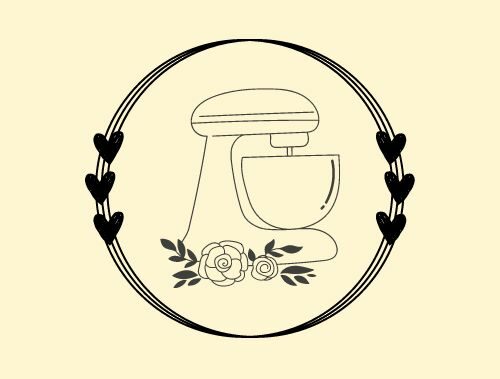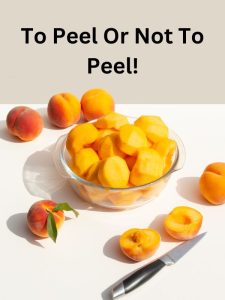You just picked up some fresh, ripe peaches from the farmer’s market, and you can’t wait to use them to make a delicious peach cobbler. But before you start mixing up the batter, you realize you’re not sure if you should peel the peaches or leave them unpeeled. Good question! But what is the answer? What are the pros and cons of peeling peaches for cobbler?
To Peel or Not To Peel
This is always the question when it comes to using peaches in baked goods. There are good reasons on both sides. Peeling them creates a smoother texture and a pretty presentation. But leaving the skin on adds flavor, color, and nutrients. So which way should you go for your cobbler? There is no right or wrong answer to this question. It all comes down to personal preference. Let’s explore the pros and cons to peel or not to peel.
Pros of Peeling Peaches

Smoother Texture
Peeling peaches will give you a smoother texture in your cobbler filling. The skins can be a little tough and fibrous once cooked. Peeling removes that layer, leaving just the soft, tender fruit behind. This can create a nicer mouthfeel with each tasty bite.
Prettier Presentation
Let’s be honest – a peach cobbler just looks more appealing in the dish when you can see those beautiful, blushing peach slices. If you leave the skins on, the peach color will be dulled down by the darker peel. So peeling can lead to a prettier, more eye-catching dessert.
Easier to Cut
Peaches can be tricky little buggers to slice cleanly. The curved shape and slippery skin make uniform cuts a challenge. Peeling them first gives you a flat surface that’s easier to slice into even pieces. No more ragged edges or skinny slices.
Cons of Peeling Peaches

Loss of Fiber and Nutrients
Peeling peaches does strip away some of the fiber and nutrients concentrated in the skin. So you’ll be sacrificing a bit of nutritional value. The skin contains antioxidants, beneficial plant compounds, and a decent amount of fiber.
Loss of Flavor
Like many fruits, much of the peach’s aromatic flavors come from the skin and flesh right under it. Peeling can remove some of those sweet, vibrant notes.
More Work
Let’s be real – peeling peaches takes more time and effort than just washing and slicing them. You’ll have slippery peach skins to wrangle and discard. So weigh whether the extra work is worth it to you.
No Eye-Catching Color
The vibrant red, yellow, and orange blush on peach skins is so gorgeous in pies and cobblers. Peeling them means you lose that splash of color.
Freestone Vs. Clingstone
I want to mention freestone and clingstone peaches. What is the difference? Have you ever bitten into that juicy peach and gotten down to the seed or pit in the center? If it comes away freely, that is a freestone peach. On the other hand, if that peach flesh clings to that seed or pit, that my friend is a clingstone peach.
Clingstone peaches are usually the first peaches that appear in the stores because they are earlier than the freestone peaches. They are also smaller than freestone peaches. Want some more information regarding freestone and clingstone peaches, you can go here.
So if you are anxious to make that cobbler when peaches first hit the stores, just be aware that they are most likely clingstone, and very difficult to separate that pit from the flesh.
What kind of Peaches Should You Use For Cobbler?

Here are a few suggestions. And if you are wondering, all these peaches are freestone.
Elberta Peaches
One of the most popular peach varieties, Elbertas are perfect for cobblers and pies. They hold their shape when baked but become tender and juicy. Well-balanced sweet-tart flavor.
Redhaven Peaches
Redhaven peaches are firm yet tender peaches with bright yellow flesh tinted red near the pit. Their sweet flavor comes through beautifully when baked.
Sun Crest Peaches
Sun Crest peaches are incredibly juicy and sweet with just a touch of tartness. Their firm flesh bakes up smooth and luscious. Definitely a top pick.
And Don’t Forget Nectarines!

Along with peaches, ripe nectarines are amazing in cobblers too. Their smooth skin means you don’t have to peel them. Just slice and add to the filling. My favorite varieties:
Arctic Sweet Zephyr Kay Pearl
Nectarines hold their shape better when baked but still become tender. Their floral, honeyed sweetness pairs perfectly with classic cobbler flavors.
Let the Peaches Ripen First
Whether using peaches, nectarines, or both – always let them ripen first for the best flavor. Leave them at room temp until softened and fragrant. Ripening enhances their natural sugars and aromas. Don’t bake with firm, unripe fruit.
My Preference
So if you are wondering what my preference is, I peel my peaches. I always have. Didn’t know any different until my daughter made a peach cobbler and brought my husband and me a couple of pieces. The first bite, and I noticed that she didn’t peel the peaches. That got me wondering if I had been doing it wrong all these years. And I started on my quest to find out the answer.
After eating her cobbler, now, don’t get me wrong, it had a wonderful taste, but I found out that I don’t care for the feel of the peach peeling in my mouth when eating it. So I wasn’t doing it wrong after all. But then, to the ones that prefer to leave the peel on, I was doing it wrong:) To each their own, I say.
Final Thoughts
In the wonderful world of baking, there are often no definitive rights or wrongs, only variations, and personal preferences. The question, “Should I peel peaches for cobbler?” is no different. Whether you choose to peel your peaches or leave them au naturel, remember, it’s the love and care you pour into your baking that truly makes a difference.In the end, the decision to peel or not to peel comes down to personal preference.
Time to Make That Cobbler!
Now you’re ready to let those delicious peaches shine in a fresh peach cobbler. I hope these tips help you decide whether or not to peel your peaches. Here is a peach cobbler recipe you might enjoy.
Do you peel your peaches? Please leave me a comment below
And As Always
Keep On Baking!
Taianne
Share The Love
FAQs About Peeling Peaches for Cobbler
Got more questions about prepping peaches for cobbler? Below I’ve answered some of the most frequently asked ones. These tips will help you easily peel, slice, and prep peaches to make the perfect cobbler filling.
How do you peel and cut peaches for cobbler?
To peel peaches, immerse them briefly in boiling water then transfer them to an ice water bath. The skins will peel off easily. Another option is using a vegetable peeler. Once peeled, cut the peaches into thin wedges or slices. An even 1/2-inch thickness works well. Remove any pits before adding the sliced peaches to the filling.
Is it better to use fresh or canned peaches for cobbler?
Fresh peaches are usually ideal for the best flavor and texture. But canned peaches work too, especially when fresh ones aren’t in season. Look for cans without added sugar. Drain and rinse the canned peaches first. You may want to add a touch more thickener to account for the extra juice.
What is the fastest way to peel peaches?
The boiling water method is the quickest for peeling peaches. Just dip them in boiling water for 30-60 seconds, then transfer them to an ice bath. The skins will slip right off with no tedious peeling needed. It takes just minutes to peel a batch of peaches this way.

I’m Taianne, the owner and operator behind We Are Baking. Baking my first cake at age 11 hooked me on creating sweet treats. Though my interest faded during childhood, it was rekindled when I married my apple pie-loving husband. I love trying new recipes, tweaking classics, and helping others learn the science and art of baking. I started We Are Baking to share tips, tricks, and favorite recipes I’ve discovered over the years. When not in the kitchen, I enjoy spending time with family and friends. My goal is to inspire others to embrace their creativity through baking. Feel free to contact me with any questions!
Taianne@wearebaking.com

